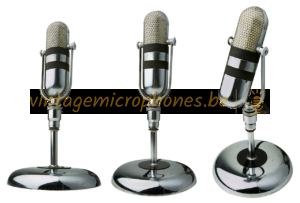What is a microphone ?
A microphone is basically a collector of sound, taking acoustical energy input and converting it to electrical energy.
The problem is that the acoustical energy contained in our voices or in musical instruments is full of sudden starts and stops.
The piano, a percussive instrument is easily capable of going from a condition of no sound to peak sound in almost no time at all.
And the sound level of some instruments, as well as the human voice, can decrease extremely rapidly.
So one of the required characteristics of a microphone is that it must be responsive to rapid changes in acoustical energy.
This is somewhat like asking an automobile to move from rest to 70 km/h down to 30 up to 45 and down to 10 practically instantaneously.
One of the problems the auto has in doing this is a law of nature which insists that a body at rest,
prefers remaining at rest and a body in motion prefers staying in motion.
More elegantly known as a law of inertia. It is as applicable to microphones as it is to cars.
The comparison isn’t quite fair, however, for the mass of a car is tremendous in comparison with the moving element of the microphone.

Making a microphone
The simplest microphone you can imagine consists of a pair of tin cans, each having a cover removed.
Any pair salvaged from the kitchen will do. Punch a hole in the center of each can and insert a length of string in the ends.
Just tie a knot on the inside of the can so the string cannot come loose. With this arrangement and with the string kept taut,
you can transmit your voice over a distance of about 20 feet.
In this setup each tin can works both as a microphone and a speaker. The acoustical energy going into one of the cans causes the
bottom cover to vibrate. This vibration is transferred to the string and travels to the other can.
The bottom of the second can will be caused to vibrate by the energy it receives from the string. But in vibrating, the can cover will
move air back and forth, in step with the sound going into the first can. This air movement, upon reaching your ear, is converted into
sound. What we have here is a transducer, changing sound energy to mechanical energy at one end, then converting that
mechanical energy back to sound energy at the other.
Granted that this is a very crude system, that the string must be kept dry, that it must be kept tight, that the communications
distance is very small, and the quality of the sound reproduction is terrible.
All this is beside the point right now. What is important is to realize that this device tells us that acoustical energy can be changed
into some other form and that the acoustical energy can be made to work as a control.
In this example, the energy produced by the human voice caused the cover of a tin can to vibrate. Not just to vibrate, mind you,
but to vibrate with the variations and changes in the human voice.
There is one other problem presented by the tin can microphone. It seduces us to talking a completely wrong path toward the
development of a microphone, for while it converts sound energy into some other form, there is no way in which we can modify,
improve, or amplify that other form.
We can change or amplify an electrical form, however, so our search for a practical microphone must take a path in which sound
energy is converted to electrical energy.


